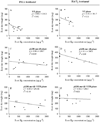Phytoremediation of mercury and organomercurials in chloroplast transgenic plants: enhanced root uptake, translocation to shoots, and volatilization
- PMID: 18200876
- PMCID: PMC2590779
- DOI: 10.1021/es070908q
Phytoremediation of mercury and organomercurials in chloroplast transgenic plants: enhanced root uptake, translocation to shoots, and volatilization
Abstract
Transgenic tobacco plants engineered with bacterial merA and merB genes via the chloroplast genome were investigated to study the uptake, translocation of different forms of mercury (Hg) from roots to shoots, and their volatilization. Untransformed plants, regardless of the form of Hg supplied, reached a saturation point at 200 microM of phenylmercuric acetate (PMA) or HgCl2, accumulating Hg concentrations up to 500 microg g(-1) with significant reduction in growth. In contrast, chloroplast transgenic lines continued to grow well with Hg concentrations in root tissues up to 2000 microg g(-1). Chloroplasttransgenic lines accumulated both the organic and inorganic Hg forms to levels surpassing the concentrations found in the soil. The organic-Hg form was absorbed and translocated more efficiently than the inorganic-Hg form in transgenic lines, whereas no such difference was observed in untransformed plants. Chloroplast-transgenic lines showed about 100-fold increase in the efficiency of Hg accumulation in shoots compared to untransformed plants. This is the first report of such high levels of Hg accumulation in green leaves or tissues. Transgenic plants attained a maximum rate of elemental-Hg volatilization in two days when supplied with PMA and in three days when supplied with inorganic-Hg, attaining complete volatilization within a week. The combined expression of merAB via the chloroplast genome enhanced conversion of Hg2+ into Hg,0 conferred tolerance by rapid volatilization and increased uptake of different forms of mercury, surpassing the concentrations found in the soil. These investigations provide novel insights for improvement of plant tolerance and detoxification of mercury.
Figures





Similar articles
-
Metallothionein expression in chloroplasts enhances mercury accumulation and phytoremediation capability.Plant Biotechnol J. 2011 Jun;9(5):609-17. doi: 10.1111/j.1467-7652.2011.00616.x. Epub 2011 Apr 24. Plant Biotechnol J. 2011. PMID: 21518240 Free PMC article.
-
Differential mercury volatilization by tobacco organs expressing a modified bacterial merA gene.Cell Res. 2001 Sep;11(3):231-6. doi: 10.1038/sj.cr.7290091. Cell Res. 2001. PMID: 11642409
-
Transgenic tobacco plant expressing environmental E. coli merA gene for enhanced volatilization of ionic mercury.J Microbiol Biotechnol. 2010 May;20(5):917-24. doi: 10.4014/jmb.1002.02001. J Microbiol Biotechnol. 2010. PMID: 20519916
-
Genetic engineering to enhance mercury phytoremediation.Curr Opin Biotechnol. 2009 Apr;20(2):213-9. doi: 10.1016/j.copbio.2009.02.010. Epub 2009 Mar 26. Curr Opin Biotechnol. 2009. PMID: 19328673 Free PMC article. Review.
-
Strategies for the engineered phytoremediation of toxic element pollution: mercury and arsenic.J Ind Microbiol Biotechnol. 2005 Dec;32(11-12):502-13. doi: 10.1007/s10295-005-0255-9. Epub 2005 Jul 2. J Ind Microbiol Biotechnol. 2005. PMID: 15995854 Review.
Cited by
-
Sources, toxicity, and remediation of mercury: an essence review.Environ Monit Assess. 2019 Aug 15;191(9):566. doi: 10.1007/s10661-019-7743-2. Environ Monit Assess. 2019. PMID: 31418123 Review.
-
Metallothionein expression in chloroplasts enhances mercury accumulation and phytoremediation capability.Plant Biotechnol J. 2011 Jun;9(5):609-17. doi: 10.1111/j.1467-7652.2011.00616.x. Epub 2011 Apr 24. Plant Biotechnol J. 2011. PMID: 21518240 Free PMC article.
-
Recent achievements obtained by chloroplast transformation.Plant Methods. 2017 Apr 19;13:30. doi: 10.1186/s13007-017-0179-1. eCollection 2017. Plant Methods. 2017. PMID: 28428810 Free PMC article. Review.
-
Utilization of Legume-Nodule Bacterial Symbiosis in Phytoremediation of Heavy Metal-Contaminated Soils.Biology (Basel). 2022 Apr 27;11(5):676. doi: 10.3390/biology11050676. Biology (Basel). 2022. PMID: 35625404 Free PMC article. Review.
-
A review on the clean-up technologies for heavy metal ions contaminated soil samples.Heliyon. 2023 Apr 15;9(5):e15472. doi: 10.1016/j.heliyon.2023.e15472. eCollection 2023 May. Heliyon. 2023. PMID: 37180942 Free PMC article. Review.
References
-
- Meagher RB. Phytoremediation of toxic elemental and organic pollutants. Curr. Opin. Plant Biol. 2000;3:153–162. - PubMed
-
- Harada M. Minamata disease: methylmercury poisoning in Japan caused by environmental pollution. Crit Rev Toxicol. 1995;25:1–24. - PubMed
-
- Patra M, Sharma A. Mercury Toxicity in Plants. Bot. Rev. 2000;66:379–422.
-
- Goldman LR, Shannon MW. The Committee on Environmental Health. Technical Report. Mercury in the environment: Implications for pediatricians. PEDIATRICS. 2001;108(1):197–205. - PubMed
-
- EPA. Clean Air Mercury Rule. Washington, DC: U.S. Environmental Protection Agency; 2005. Mar,
Publication types
MeSH terms
Substances
Grants and funding
LinkOut - more resources
Full Text Sources
Medical

